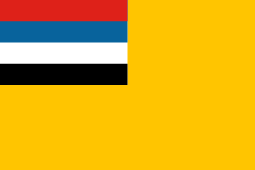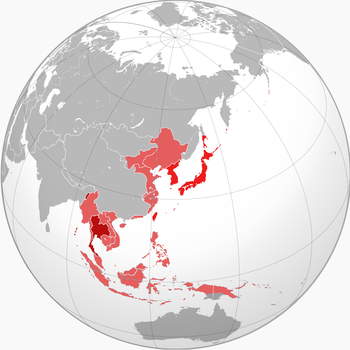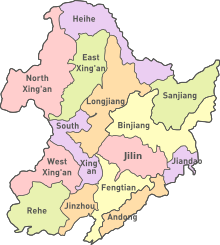Manchukuo
Manchukuo, officially the State of Manchuria prior to 1934 and the Empire of Manchuria after 1934, was a puppet state of the Empire of Japan in Northeast China and Inner Mongolia from 1932 until 1945. It was founded in 1932 after the Japanese invasion of Manchuria, and in 1934 it became a constitutional monarchy. Under the de facto control of Japan, it had limited international recognition.
State of Manchuria (1932–1934) 滿洲國 Empire of (Great) Manchuria (1934–1945) (大)滿洲帝國 | |||||||||
|---|---|---|---|---|---|---|---|---|---|
| 1932–1945 | |||||||||
Motto: "Five Races Under One Union" | |||||||||
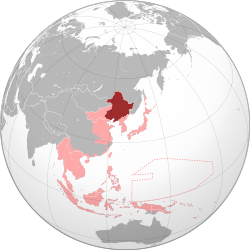 Manchukuo (dark red) within the Empire of Japan (light red) at its furthest extent | |||||||||
| Status | Client state/Puppet state/Buffer state of the Empire of Japan | ||||||||
| Capital | Hsinking (Changchun) (until 9 August 1945) Tunghwa (from 9 August 1945) | ||||||||
| Common languages | Japanese Manchu Mandarin Mongolian | ||||||||
| Religion | State Shinto | ||||||||
| Government | Personalist one-party constitutional monarchy under a totalitarian military dictatorship | ||||||||
| Chief Executive | |||||||||
• 1932–1934 | Aisin-Gioro Puyi | ||||||||
| Emperor | |||||||||
• 1934–1945 | Aisin-Gioro Puyi | ||||||||
| Prime Minister | |||||||||
• 1932–1935 | Zheng Xiaoxu | ||||||||
• 1935–1945 | Zhang Jinghui | ||||||||
| Legislature | Legislative Council | ||||||||
| Historical era | Interbellum · World War II | ||||||||
• Established | 1 March 1932 | ||||||||
| 4 March 1933 | |||||||||
• Empire proclaimed | 1 March 1934 | ||||||||
• Member of GEACPS | 30 November 1940 | ||||||||
| 9 August 1945 | |||||||||
| 18 August 1945 | |||||||||
| Area | |||||||||
| 1940 | 1,192,081 km2 (460,265 sq mi) | ||||||||
| Population | |||||||||
• 1940 | 43,233,954 | ||||||||
| Currency | Manchukuo yuan | ||||||||
| |||||||||
| Today part of | China | ||||||||
| Manchukuo | |||||||||||||||||||||
|---|---|---|---|---|---|---|---|---|---|---|---|---|---|---|---|---|---|---|---|---|---|
| Chinese name | |||||||||||||||||||||
| Traditional Chinese | 滿洲國 | ||||||||||||||||||||
| Simplified Chinese | 满洲国 | ||||||||||||||||||||
| Literal meaning | State of Manchuria | ||||||||||||||||||||
| |||||||||||||||||||||
| Japanese name | |||||||||||||||||||||
| Kana | まんしゅうこく | ||||||||||||||||||||
| Kyūjitai | 滿洲國 | ||||||||||||||||||||
| Shinjitai | 満州国 | ||||||||||||||||||||
| |||||||||||||||||||||
| Other names | |||||||||||||||||
|---|---|---|---|---|---|---|---|---|---|---|---|---|---|---|---|---|---|
| Manchutikuo | |||||||||||||||||
| Traditional Chinese | 滿洲帝國 | ||||||||||||||||
| Simplified Chinese | 满洲帝国 | ||||||||||||||||
| Literal meaning | Empire of Manchuria Manchurian Empire | ||||||||||||||||
| |||||||||||||||||
| Great Manchurian Empire | |||||||||||||||||
| Traditional Chinese | 大滿洲帝國 | ||||||||||||||||
| Simplified Chinese | 大满洲帝国 | ||||||||||||||||
| Literal meaning | Great Manchurian Empire | ||||||||||||||||
| |||||||||||||||||
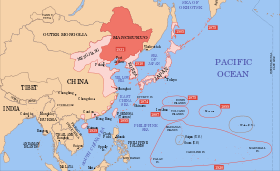
The area was the homeland of the Manchus, including the emperors of the Qing dynasty. In 1931, the region was seized by Japan following the Mukden Incident. A pro-Japanese government was installed one year later with Puyi, the last Qing emperor, as the nominal regent and later emperor.[1] Manchukuo's government was dissolved in 1945 after the surrender of Imperial Japan at the end of World War II. The territories claimed by Manchukuo were first seized in the Soviet invasion of Manchuria in August 1945,[2] and then formally transferred to Chinese administration in the following year.[note 1]
Manchus formed a minority in Manchukuo, whose largest ethnic group was Han Chinese. The population of Koreans increased during the Manchukuo period, and there were also Japanese, Mongols, White Russians and other minorities. The Mongol regions of western Manchukuo were ruled under a slightly different system in acknowledgement of the Mongolian traditions there. The southern tip of the Liaodong Peninsula (present-day Dalian) continued to be directly ruled by Japan as the Kwantung Leased Territory.
Names
"Manchukuo" is a variant of the Wade-Giles romanization Man-chou-kuo of the Mandarin pronunciation Mǎnzhōuguó of the original Japanese name of the state, Manshūkoku (満州国). In Japanese, the name refers to the state of Manchuria, the region of the Manchus. The English name, adapted to incorporate the word Manchu, would mean the state of the Manchu people. Indeed, Manchukuo was often referred to in English as simply "Manchuria", a name for Northeast China which had been particularly employed by the Imperial Japanese to promote its separation from the rest of the country.[3][4] Other European languages used equivalent terms: Manchukuo was known to its allies as Manciukuò in Italian and Mandschukuo or Mandschureich in German. In present-day Chinese, Manchukuo's name is still often prefaced by the word wěi (偽, "so-called", "false", "pseudo-", &c.) to stress its perceived illegitimacy.[5]
The formal name of the country was changed to the "Empire of Manchuria" (sometimes referred to as "Manchutikuo"), after the establishment of Puyi as the Kangde Emperor in 1934. In Chinese and Japanese, the names were Dà Mǎnzhōu dìguó and Dai Manshū teikoku. The Dà/Dai 大 ("big", "great") were added after the model of the formal names of the Great Ming and Qing dynasties, but this was unused in English.
The Japanese had their own motive for deliberately spreading the usage of the term Manchuria.[4] The historian Norman Smith wrote that "The term "Manchuria" is controversial".[6] Professor Mariko Asano Tamanoi said that she "should use the term in quotation marks", when referring to Manchuria.[7] Herbert Giles wrote that "Manchuria" was unknown to the Manchus themselves as a geographical expression.[8] In his doctoral thesis of 2012, Professor Chad D. Garcia noted that usage of the term "Manchuria" was out of favor in "current scholarly practice" and preferred the term "the northeast".[9]
History
Background
The Qing dynasty, which replaced the Shun and Ming dynasties in China, was founded by Manchus from Manchuria (modern Northeast China). The Manchu emperors separated their homeland in Jilin and Heilongjiang from the Han Liaoning province with the Willow Palisade. This ethnic division continued until the Qing dynasty encouraged massive immigration of Han in the 19th century during Chuang Guandong to prevent the Russians from seizing the area from the Qing. After conquering the Ming, the Qing identified their state as "China" (中國, Zhongguo; "Central Realm") and referred to it as "Dulimbai Gurun" in Manchu.[10][11][12] The Qing equated the lands of the Qing state (including present day Manchuria, Xinjiang, Mongolia, Tibet and other areas) as "China" in both the Chinese and Manchu languages, defining China as a multi-ethnic state, rejecting the idea that China only meant Han areas, proclaiming that both Han and non-Han peoples were part of "China", using "China" to refer to the Qing in official documents, international treaties, and foreign affairs, and the "Chinese language" (Dulimbai gurun i bithe) referred to Chinese, Manchu, and Mongol languages, and the term "Chinese people" (中國人 Zhongguo ren; Manchu: Dulimbai gurun i niyalma) referred to all Han, Manchus, and Mongol subjects of the Qing. The lands in Manchuria were explicitly stated by the Qing to belong to "China" (Zhongguo, Dulimbai gurun) in Qing edicts and in the Treaty of Nerchinsk.[13]
During the Qing dynasty, the area of Manchuria was known as the "three eastern provinces" (三東省; Sān dōng shěng) since 1683 when Jilin and Heilongjiang were separated even though it was not until 1907 that they were turned into actual provinces.[14] The area of Manchuria was then converted into three provinces by the late Qing government in 1907. Since then, the "Three Northeast Provinces" (traditional Chinese: 東北三省; simplified Chinese: 东北三省; pinyin: Dōngběi Sānshěng) was officially used by the Qing government in China to refer to this region, and the post of Viceroy of Three Northeast Provinces was established to take charge of these provinces.
As the power of the court in Beijing weakened, many outlying areas either broke free (such as Kashgar) or fell under the control of Imperialist powers. In the 19th century, Imperial Russia was most interested in the northern lands of the Qing Empire. In 1858, Russia gained control over a huge tract of land called Outer Manchuria thanks to the Supplementary Treaty of Beijing that ended the Second Opium War.[15] But Russia was not satisfied and, as the Qing Dynasty continued to weaken, it made further efforts to take control of the rest of Manchuria. Inner Manchuria came under strong Russian influence in the 1890s with the building of the Chinese Eastern Railway through Harbin to Vladivostok.[16]
The far right wing Japanese ultra-nationalist Black Dragon Society supported Sun Yat-sen's activities against the Manchus, believing that overthrowing the Qing would help the Japanese take over the Manchu homeland and that Han Chinese would not oppose the takeover. The far right wing Japanese ultranationalist Gen'yōsha leader Tōyama Mitsuru believed that the Japanese could easily take over Manchuria and Sun Yat-sen and other anti-Qing revolutionaries would not resist and help the Japanese take over and enlargen the opium trade in China while the Qing was trying to destroy the opium trade. The Japanese Black Dragons supported Sun Yat-sen and anti-Manchu revolutionaries until the Qing collapsed.[17] Toyama supported anti-Manchu, anti-Qing revolutionary activities including by Sun Yat-sen and supported Japanese taking over Manchuria. The anti-Qing Tongmenghui was founded and based in exile in Japan where many anti-Qing revolutionaries gathered.
The Japanese had been trying to unite anti-Manchu groups made out of Han people to take down the Qing. Japanese were the ones who helped Sun Yat-sen unite all anti-Qing, anti-Manchu revolutionary groups together and there were Japanese like Tōten Miyazaki inside of the anti-Manchu Tongmenghui revolutionary alliance. The Black Dragon Society hosted the Tongmenghui in its first meeting.[18] The Black Dragon Society had very intimate relations with Sun Yat-sen and promoted pan-Asianism and Sun sometimes passed himself off as Japanese.[19] That had connections with Sun for a long time.[20] Japanese groups like the Black Dragon Society had a large impact on Sun Yat-sen.[21] According to an American military historian, Japanese military officers were part of the Black Dragon Society. The Yakuza and Black Dragon Society helped arrange in Tokyo for Sun Yat-sen to hold the first Kuomintang meetings, and were hoping to flood China with opium and overthrow the Qing and deceive Chinese into overthrowing the Qing to Japan's benefit. After the revolution was successful, the Japanese Black Dragons started infiltrating China and spreading opium and anti-Communist sentiment. The Black Dragons pushed for the takeover of Manchuria by Japan in 1932.[22]
Origins
As a direct result of the Russo-Japanese War (1904–05), Japanese influence replaced Russia's in Inner Manchuria. During the war with Russia, Japan had mobilized one million soldiers to fight in Manchuria, meaning that one in eight families in Japan had a member fighting the war.[23] During the Russo-Japanese War, the losses were heavy with Japan losing a half-million dead or wounded.[23] From the time of the Russian-Japanese war onward, many Japanese people came to have a proprietary attitude to Manchuria, taking the viewpoint that a land where so much Japanese blood had been lost in some way now belonged to them.[23] In 1906, Japan established the South Manchurian Railway on the former Chinese Eastern Railway built by Russia from Manzhouli to Vladivostok via Harbin with a branch line from Harbin to Port Arthur (Japanese: Ryojun), today's Dalian. Under the terms of the Treaty of Portsmouth, the Kwantung Army had the right to occupy southern Manchuria while the region fell into the Japanese economic sphere of influence.[24] The Japanese-owned South Manchurian Railroad company had a market capitalization of 200 million yen, making it Asia's largest corporation, which went beyond just running the former Russian railroad network in southern Manchuria to owning the ports, mines, hotels, telephone lines, and sundry other businesses, dominating the economy of Manchuria.[24] With the growth of the South Manchuria Railroad (Mantetsu) company went growth in number of Japanese living in Manchuria from 16,612 Japanese civilians in 1906 to 233,749 in 1930.[23] The majority of blue collar employees for the Mantetsu were Chinese, and the Japanese employees were mostly white collar, meaning most of the Japanese living in Manchuria were middle-class people who saw themselves as an elite.[25] Between World War I and World War II Manchuria became a political and military battleground between Russia, Japan, and China. Japan moved into Outer Manchuria as a result of the chaos following the Russian Revolution of 1917. A combination of Soviet military successes and American economic pressure forced the Japanese to withdraw from the area, however, and Outer Manchuria returned to Soviet control by 1925.
During the Warlord Era in China, the warlord Marshal Zhang Zuolin established himself in Inner Manchuria with Japanese backing.[26] Later, the Japanese Kwantung Army found him too independent, so he was assassinated in 1928. In assassinating Marshal Zhang, the "Old Marshal" the Kwantung Army generals expected Manchuria to descend into anarchy, providing the pretext for seizing the region.[24] Marshal Zhang was killed when the bridge his train was riding across was blown up while three Chinese men were murdered and explosive equipment placed on their corpses to make it appear that they were the killers, but the plot was foiled when Zhang's son Zhang Xueliang, the "Young Marshal" succeeded him without incident while the cabinet in Tokyo refused to send additional troops to Manchuria.[24] Given that the Kwantung Army had assassinated his father, the "Young Marshal"—who unlike his father was a Chinese nationalist—had strong reasons to dislike Japan's privileged position in Manchuria.[27] Marshal Zhang knew his forces were too weak to expel the Kwantung Army, but his relations with the Japanese were unfriendly right from the start.[27]
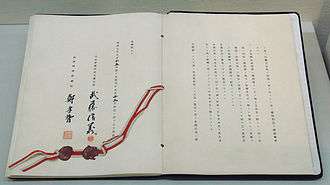
After the Japanese invasion of Manchuria in 1931, Japanese militarists moved forward to separate the region from Chinese control and to create a Japanese-aligned puppet state. To create an air of legitimacy, the last Emperor of China, Puyi, was invited to come with his followers and act as the head of state for Manchuria. One of his faithful companions was Zheng Xiaoxu, a Qing reformist and loyalist.[28]
On 18 February 1932[29] Manchukuo ("The Manchurian State") was proclaimed, officially founded on 1 March. It was recognized by Japan on 15 September 1932 through the Japan–Manchukuo Protocol,[30] after the assassination of Japanese Prime Minister Inukai Tsuyoshi. The city of Changchun, renamed Hsinking (Chinese: 新京; pinyin: Xinjing; lit.: 'New Capital'), became the capital of the new entity. Chinese in Manchuria organized volunteer armies to oppose the Japanese and the new state required a war lasting several years to pacify the country.
The Japanese initially installed Puyi as Head of State in 1932, and two years later he was declared Emperor of Manchukuo with the era name of Kangde (康德, w Kang-te, "Tranquility and Virtue"). Manchukuo thus became Manchutikuo ("The Manchurian Empire"). Zheng Xiaoxu served as Manchukuo's first prime minister until 1935, when Zhang Jinghui succeeded him. Puyi was nothing more than a figurehead and real authority rested in the hands of the Japanese military officials. An imperial palace was specially built for the emperor. The Manchu ministers all served as front-men for their Japanese vice-ministers, who made all decisions.[31]
In this manner, Japan formally detached Manchukuo from China over the course of the 1930s. With Japanese investment and rich natural resources, the area became an industrial powerhouse. Manchukuo had its own issued banknotes and postage stamps.[32][33][34] Several independent banks were founded as well.
The conquest of Manchuria proved to be extremely popular with the Japanese people who saw the conquest as providing a much needed economic "lifeline" to their economy which had been badly hurt by the Great Depression.[35] The very image of a "lifeline" suggested that Manchuria—which was rich in natural resources—was essential for Japan to recover from the Great Depression, which explains why the conquest was so popular at the time and later why the Japanese people were so completely hostile towards any suggestion of letting Manchuria go.[36] At the time, censorship in Japan was nowhere near as stringent as it later become, and the American historian Louise Young noted: "Had they wished, it would have been possible in 1931 and 1932 for journalists and editors to express anti-war sentiments".[37] The popularity of the conquest meant that newspapers such as the Asahi Shimbun which initially opposed the war swiftly changed to supporting the war as the best way of improving sales.[37]
In 1935, Manchukuo bought the Chinese Eastern Railway from the Soviet Union.[38]
Diplomatic recognition
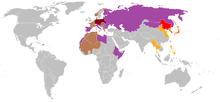
China did not recognize Manchukuo but the two sides established official ties for trade, communications and transportation. In 1933, the League of Nations adopted the Lytton Report, declaring that Manchuria remained rightfully part of China, leading Japan to resign its membership. The Manchukuo case persuaded the United States to articulate the so-called Stimson Doctrine, under which international recognition was withheld from changes in the international system created by force of arms.[39]
In spite of the League's approach, the new state was diplomatically recognized by El Salvador (3 March 1934) and the Dominican Republic (1934), Costa Rica (23 September 1934), Italy (29 November 1937), Spain (2 December 1937), Germany (12 May 1938) and Hungary (9 January 1939). The Soviet Union extended de facto recognition on 23 March 1935, but explicitly noted that this did not mean de jure recognition.[40][41] However, upon signing the Soviet–Japanese Neutrality Pact on 13 April 1941, the Soviet Union recognized Manchukuo de jure in exchange for Japan recognizing the integrity of the neighboring Mongolian People's Republic.[42] The USSR did maintain five consulates-general in Manchukuo initially, although in 1936–37 these were reduced to just two: one in Harbin and another in Manzhouli.[43][44][45] Manchukuo opened consulates in Blagoveshchensk (September 1932) and in Chita (February 1933).[46]
It is commonly believed that the Holy See established diplomatic relations with Manchukuo in 1934, but the Holy See never did so. This belief is partly due to the erroneous reference in Bernardo Bertolucci's 1987 film The Last Emperor that the Holy See diplomatically recognized Manchukuo. Bishop Auguste Ernest Pierre Gaspais was appointed as "representative ad tempus of the Holy See and of the Catholic missions of Manchukuo to the government of Manchukuo" by the Congregation De Propaganda Fide (a purely religious body responsible for missions) and not by the Secretariat of State responsible for diplomatic relations with states.[47] In the 1940s the Vatican established full diplomatic relations with Japan, but it resisted Japanese and Italian pressure to recognize Manchukuo and the Nanjing regime.[48]
After the outbreak of World War II, the state was recognized by Slovakia (1 June 1940), Vichy France (12 July 1940), Romania (1 December 1940), Bulgaria (10 May 1941), Finland (17 July 1941),[49] Denmark (August 1941), Croatia (2 August 1941)—all controlled or influenced by Japan's ally Germany—as well as by Wang Jingwei's Reorganized National Government of the Republic of China (30 November 1940), Thailand (5 August 1941) and the Philippines (1943)—all under the control or influence of Japan.
World War II and aftermath
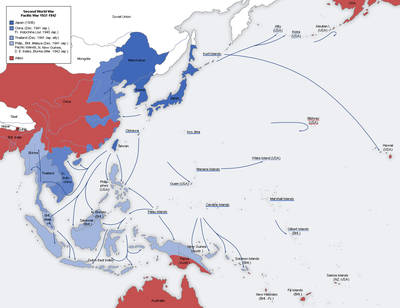
Before World War II, the Japanese colonized Manchukuo and used it as a base from which to invade China. The Manchu General Tong Linge was killed in action by the Japanese in the Battle of Beiping–Tianjin, which marked the beginning of the Second Sino-Japanese War.[50][51][52] In the summer of 1939 a border dispute between Manchukuo and the Mongolian People's Republic resulted in the Battle of Khalkhin Gol. During this battle, a combined Soviet-Mongolian force defeated the Japanese Kwantung Army (Kantōgun) supported by limited Manchukuoan forces.[53]
On 8 August 1945, the Soviet Union declared war on Japan, in accordance with the agreement at the Yalta Conference, and invaded Manchukuo from outer Manchuria and Outer Mongolia. During the Soviet offensive, the Manchukuo Imperial Army, on paper a 200,000-man force, performed poorly and whole units surrendered to the Soviets without firing a single shot; there were even cases of armed riots and mutinies against the Japanese forces.[54] Emperor Kangde had hoped to escape to Japan to surrender to the Americans, but the Soviets captured him and eventually extradited him to the communist government in China, where the authorities had him imprisoned as a war criminal along with all other captured Manchukuo officials.[55]
From 1945 to 1948, Manchuria (Inner Manchuria) served as a base area for the People's Liberation Army in the Chinese Civil War against the National Revolutionary Army.[56] The Chinese Communists used Manchuria as a staging ground until the final Nationalist retreat to Taiwan in 1949. Many Manchukuo army and Japanese Kantōgun personnel served with the communist troops during the Chinese Civil War against the Nationalist forces. Most of the 1.5 million Japanese who had been left in Manchukuo at the end of World War II were sent back to their homeland in 1946–1948 by U.S. Navy ships in the operation now known as the Japanese repatriation from Huludao.[57]
Administrative divisions
During its short-lived existence, Manchukuo was divided into between five (in 1932) and 19 (in 1941) provinces, one special ward of Beiman (Chinese: 北滿特別區) and two Special cities which were Xinjing (Chinese: 新京特別市) and Harbin (Chinese: 哈爾濱特別市). Each province was divided into between four (Xing'an dong) and 24 (Fengtian) prefectures. Beiman lasted less than 3 years (1 July 1933 – 1 January 1936) and Harbin was later incorporated into Binjiang province. Longjiang also existed as a province in 1932 before being divided into Heihe, Longjiang and Sanjiang in 1934. Andong and Jinzhou provinces separated themselves from Fengtian while Binjiang and Jiandao from Jilin separated themselves in the same year.
Politics
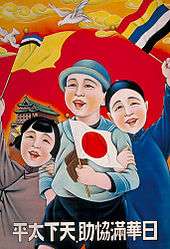
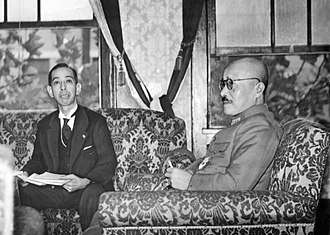
Historians generally consider Manchukuo a puppet state of Imperial Japan[58] because of the Japanese military's strong presence and strict control of the government administration. Chinese historians generally refer to the state as Wei Manzhouguo ("false state of Manchuria"). Some historians see Manchukuo as an effort at building a glorified Japanese state in mainland Asia that deteriorated due to the pressures of war.[59]
The independence of Manchuria was proclaimed on 18 February 1932 and officially founded on 1 March. The Japanese military commander appointed Puyi as regent (reign name Datong) for the time being, stating that he would become Emperor of Manchukuo but could not reign using the title of Emperor of the Great Qing Empire as he once held. Manchukuo was proclaimed a monarchy on 1 March 1934, with Puyi assuming the throne under the reign name of Emperor Kang-de. Puyi was assisted in his executive duties by a Privy Council (Chinese: 參議府), and a General Affairs State Council (Chinese: 國務院). This State Council was the center of political power, and consisted of several cabinet ministers, each assisted by a Japanese vice-minister.
The commanding officer of the Kwantung Army in Manchukuo was also the Japanese ambassador to Manchukuo. He functioned in a manner similar to that of a British resident officer in British overseas protectorates, with the power to veto decisions by the emperor. The Kwangtung Army leadership placed Japanese vice ministers in his cabinet, while all Chinese advisors gradually resigned or were dismissed.
The Legislative Council (Chinese: 立法院) was largely a ceremonial body, existing to rubber-stamp decisions issued by the State Council. The only authorized political party was the government-sponsored Concordia Association, although various émigré groups were permitted their own political associations.
The American historian Louise Young noted that one of the most striking aspects of Manchukuo was that many of the young Japanese civil servants who went to work in Manchukuo were on the left, or at least had once been.[60] In the 1920s, much of the younger intelligentsia in Japan had rejected their parents' values, and had become active in various left-wing movements. Starting with the Peace Preservation Law of 1925, which made the very act of thinking about "altering the kokutai a crime, the government had embarked on a sustained campaign to stomp out all left-wing thought in Japan. However, many of the bright young university graduates active in left-wing movements in Japan were needed to serve as civil servants in Manchukuo, which Young noted led the Japanese state to embark upon a contradictory policy of recruiting the same people active in the movements that it was seeking to crush."[60] To rule Manchukuo, which right from the start had a very statist economy, the Japanese state needed university graduates who were fluent in Mandarin Chinese, and the 1920s–30s, many of the university graduates in Japan who knew Mandarin were "progressives" involved in left-wing causes.[61] The fact that young Japanese civil servants in Manchukuo with their degrees in economics, sociology, etc., who had once been active in left-wing movements helps explain the decidedly leftist thrust of social and economic policies in Manchukuo with the state playing an increasingly large role in society.[61] Likewise, much of the debate between Japanese civil servants about the sort of social-economic policies Japan should follow in Manchukuo in the 1930s was framed in Marxist terms, with the civil servants arguing over whatever Manchuria prior to September 1931 had a "feudal" or a "capitalist" economy.[62] The American historian Joshua Fogel wrote about the young servants of Manchukuo: "Tremendous debates transpired on such things as the nature of the Chinese economy, and the lingua franca of these debates was always Marxism".[63] To resolve this debate, various research teams of five or six young civil servants, guarded by detachments from the Kwantung Army of about 20 or 30 men, went out to do field research in Manchukuo, gathering material about the life of ordinary people, to determine Manchukuo was in the "feudal" or "capitalist" stage of development.[64] Starting in 1936, the Manchukuo state launched Five Year Plans for economic development, which were closely modeled after the Five Year Plans in the Soviet Union.[65]
In Manchukuo, the Japanese were creating a brand new state that was in theory independent, which meant that there were no limits upon the sort of policies that the new state could carry out, and many university graduates in Japan, who despite being opposed to the social system that existed in Japan itself, went to work in Manchukuo, believing that they could carry out reforms there that might inspire similar reforms in Japan.[66] This was especially the case since it was impossible to effect any reforms in Japan itself as the very act of thinking about "altering the kokutai" was a crime, which led many leftist Japanese university graduates to go work in Manchukuo, where they believed they could achieve the sort of social revolution that was impossible in Japan.[67] By 1933, the Japanese state had essentially destroyed both the Japanese Socialist Party and the Japanese Communist Party via mass arrests and Tenkō with both parties reduced down to mere rumps, which caused many Japanese student leftists to draw the conclusion that change was impossible in Japan, but still possible in Manchukuo, where paradoxically the Kwantung Army was sponsoring the sort of policies that were unacceptable in Japan.[68] Moreover, the Great Depression had made it very difficult for university graduates in Japan to find work, which made the prospect of a well-paying job in Manchukuo very attractive to otherwise underemployed Japanese university graduates.[69] In Manchukuo, the Japanese state was creating an entire state anew, which meant that Manchukuo had a desperate need for university graduates to work in its newly founded civil service.[70] In addition, the Pan-Asian rhetoric of Manchukuo and the prospect of Japan helping ordinary people in Manchuria greatly appealed to the idealistic youth of Japan.[69] Young wrote about the young Japanese people who went to work in Manchukuo: "The men, and in some cases, the women, who answered the call of this land of opportunity, brought with them tremendous drive and ambition. In their efforts to remake their own lives, they remade an empire. They invested it with their preoccupations of modernity and their dreams of an Utopian future. They pushed it to embrace an idealist rhetoric of social reform and justified itself in terms of Chinese nationalist aspiration. They turned it to architectural ostentation and the heady luxury of colonial consumption. They made it into a project of radical change, experimentation and possibility".[69]
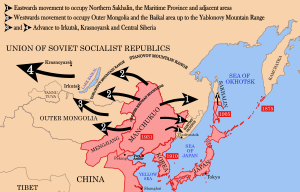
The Kwantung Army for its part tolerated the talk of social revolution in Manchukuo as the best way of gaining support from the Han majority of Manchukuo, who did not want Manchuria to be severed from China.[71] Even more active in going to Manchukuo were the products of Tenkō ("Changing directions"), a process of brainwashing by the police of left-wing activists to make them accept that the Emperor was a god after all, whom they were best to serve.[72] Tenkō was a very successful process that turned young Japanese who once been ardent liberals or leftists who rejected the idea that the Emperor was a god into fanatical rightists, who made up for their previous doubts about the divinity of the Emperor with militant enthusiasm.[72] One tenkōsha was Tachibana Shiraki, who once been a Marxist Sinologist who after his arrest and undergoing Tenkō become a fanatical right-winger.[72] Tachibana went to Manchukuo in 1932, proclaiming that the theory of the "five races" working together was the best solution to Asia's problems and argued in his writings that only Japan could save China from itself, which was a complete change from his previous policies, where he criticized Japan for exploiting China.[72] Other left-wing activists like Ōgami Suehiro did not undergo Tenkō, but still went to work in Manchukuo, believing it was possible to effect social reforms that would end the "semi-feudal" condition of the Chinese peasants of Manchukuo, and that he could use the Kwantung Army to effect left-wing reforms in Manchukuo.[72] Ōgami went to work in the "agricultural economy" desk of the Social Research Unit of the South Manchurian Railroad company, writing up reports about the rural economy of Manchukuo that were used by the Kwantung Army and the Manchukuo state.[73] Ōgami believed that his studies helped ordinary people, citing one study he did about water use in rural Manchukuo, where he noted a correlation between villages that were deprived of water and "banditry" (the codeword for anti-Japanese guerrillas), believing that the policy of improving water supply in villages was due to his study.[63] The outbreak of the war with China in 1937 caused the state in Manchukuo to grow even bigger as a policy of "total war" came in, which meant there was a pressing demand for people with university degrees trained to think "scientifically".[70] Fogel wrote that almost all of the university graduates from Japan who arrived in Manchukuo in the late 1930s were "largely left-wing Socialists and Communists. This was precisely at the time when Marxism had been all but banned in Japan, when (as Yamada Gōichi put) if the expression shakai (social) appeared in the title of a book, it was usually confiscated".[70]
Young also noted—with reference to Lord Acton's dictum that "Absolute power corrupts absolutely"—that for many of the idealistic young Japanese civil servants, who believed that they could effect a "revolution from above" that would make the lives of ordinary people better, that the absolute power that they enjoyed over millions of people "went to their heads", causing them to behave with abusive arrogance towards the very people that they had gone to Manchukuo to help.[65] Young wrote that it was a "monumental conceit" of the part of the young idealists to believe that they could use the Kwantung Army to achieve a "revolution from above", when it was the Kwantung Army that was using them.[65] The ambitious plans for land reform in Manchukuo were vetoed by the Kwantung Army for precisely the reason that it might inspire similar reforms in Japan.[74] The landlords in Japan tended to come from families who once belonged to the samurai caste, and almost all of the officers in the Imperial Japanese Army came from samurai families, which made the Kwantung Army very hostile towards any sort of land reform which might serve as an example for Japanese peasants. In October 1941, the Soviet spy ring headed by Richard Sorge was uncovered in Tokyo, which caused the authorities to become paranoid about Soviet espionage, and led to new crackdown on the left. In November 1941, the Social Research Unit of the South Manchurian Railroad Company, which was well known as a hotbed of Marxism since the early 1930s, was raided by the Kenpeitai, who arrested 50 of those working in the Social Research Unit.[75] At least 44 of those working in the Social Research Unit were convicted of violating the Peace Preservation Law, which made thinking about "altering the kokutai" a crime in 1942–43 and were given long prison sentences, of whom four died due to the harsh conditions of prisons in Manchukuo.[76] As the men working in the Social Research Unit had played important roles in Manchukuo's economic policy and were university graduates from good families, the Japanese historian Hotta Eri wrote that the Kenpeitai were ordered to "handle them with care", meaning no torture of the sort that the Kenpeitai normally employed in its investigations.[76]
When the Japanese surrender was announced on 15 August 1945, Puyi agreed to abdicate.
Head of State
| Emperor of Manchukuo | |
|---|---|
Imperial | |
 Imperial Standard | |
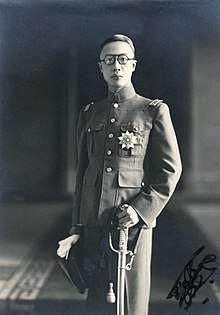 Kāngdé | |
| Details | |
| Style | His Imperial Majesty |
| First monarch | Puyi |
| Last monarch | Puyi |
| Formation | 1 March 1934 |
| Abolition | 15 August 1945 |
| Residence | Imperial Palace |
| Personal Names | Period of Reigns | Era names (年號) and their corresponding range of years | ||
|---|---|---|---|---|
| All given names in bold. | ||||
| Aisin-Gioro Puyi 愛新覺羅溥儀 Àixīnjuéluó Pǔyì | 9 March 1932 – 15 August 1945 | Datong (大同 Dàtóng) 1932–1934 Kangde (康德 Kāngdé) 1934–1945 | ||
Prime Minister
| No. | Portrait | Name (Born-Died) |
Term of office | Political Party | ||
|---|---|---|---|---|---|---|
| Took office | Left office | Time in office | ||||
| 1 | 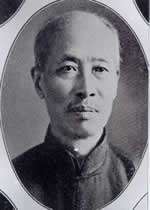 | Zheng Xiaoxu (1860–1938) | 9 March 1932 | 21 May 1935 | 3 years, 73 days | Concordia Association |
| 2 | Zhang Jinghui (1871–1959) | 21 May 1935 | 15 August 1945 | 10 years, 86 days | Concordia Association | |
Demographics
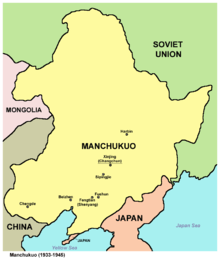
In 1908, the number of residents was 15,834,000, which rose to 30,000,000 in 1931 and 43,000,000 for the Manchukuo state. The population balance remained 123 men to 100 women and the total number in 1941 was 50,000,000. Other statistics indicate that in Manchukuo the population rose by 18,000,000.
In early 1934, the total population of Manchukuo was estimated as 30,880,000, with 6.1 persons the average family, and 122 men for each 100 women. These numbers included 29,510,000 Chinese (96%, which should have included the Manchurian population), 590,760 Japanese (2%), 680,000 Koreans (2%), and 98,431 (<1%) of other nationality: White Russians, Mongols, etc. Around 80% of the population was rural. During the existence of Manchukuo, the ethnic balance did not change significantly, except that Japan increased the Korean population in China. From Japanese sources come these numbers: in 1940 the total population in Manchukuo of Lungkiang, Jehol, Kirin, Liaoning (Fengtian) and Xing'an provinces at 43,233,954; or an Interior Ministry figure of 31,008,600. Another figure of the period estimated the total population as 36,933,000 residents. The majority of Han Chinese in Manchukuo believed that Manchuria was rightfully part of China, who both passively and violently resisted Japan's propaganda that Manchukuo was a "multinational state".[77]
After the Russian Civil War (1917–1922), thousands of Russians fled to Manchuria to join the Russian community already there. The Russians living in Manchuria were stateless and as whites had an ambiguous status in Manchukuo, which was meant to be a Pan-Asian state, whose official "five races" were the Chinese, Mongols, Manchus, Koreans and Japanese.[78] At various times, the Japanese suggested that the Russians might be a "sixth race" of Manchukuo, but this was never officially declared.[79] In 1936, the Manchukuo Almanac reported that were 33,592 Russians living in the city of Harbin—the "Moscow of the Orient"—and of whom only 5,580 had been granted Manchukuo citizenship.[80] Japanese imperialism was to a certain extent based on racism with the Japanese as the "great Yamato race", but there was always a certain dichotomy in Japanese thinking between an ideology based on racial differences based on bloodlines versus the idea of Pan-Asianism with Japan as the natural leader of all the Asian peoples.[81] In 1940, ethnic Russians were included among the other nationalities of Manchukuo as candidates for conscription into the Manchukuo military.[82]
The British writer Peter Fleming visited Manchukuo in 1935, and while riding a train through the countryside of Manchukuo, a group of Japanese colonists mistook his Swiss traveling companion Kini for a Russian refugee, and began to beat her up.[83] It was only after Fleming was able to prove to the Japanese that she was Swiss, not Russian, that the Japanese stopped and apologized, saying that they would never had beaten her up if they had known she was Swiss, saying that they sincerely believed she was a Russian when they assaulted her.[83] Fleming observed that in Manchukuo: "you can beat White Russians up till you are blue in the face, because they are people without status in the world, citizens of nowhere".[84] Fleming further noted that the Japanese in Manchukuo had a strong dislike of all white people, and because the Russians in Manchukuo were stateless without an embassy to issue protests if they were victimized, the Japanese liked to victimize them.[85] Until World War II, the Japanese tended to leave alone those travelling to Manchukuo with a passport as they did not like to deal with protests from embassies in Tokyo about the mistreatment of their citizens.[83] The Kwantung Army operated a secret biological-chemical warfare unit based in Pinfang, Unit 731, that performed gruesome experiments on people involving much visceration of the subjects to see the effects of chemicals and germs on the human body. In the late 1930s, the doctors of Unit 731 demanded more white subjects to experiment upon in order to test the efficiency the strains of anthrax and plague that they were developing leading to a great many of the Russians living in Manchukuo becoming the unwilling human guinea pigs of Unit 731.[86] The Russian Fascist Party, which worked with the Japanese was used to kidnap various "unreliable" Russians living in Manchukuo for Unit 731 to experiment upon.[86]
The children of the Russian exiles often married Han Chinese, and the resulting children were always known in Manchukuo as "mixed water" people, who were shunned by both the Russian and Chinese communities.[87] Chinese accounts, both at the time and later, tended to portray the Russians living in Manchuria as all prostitutes and thieves, and almost always ignored the contributions made by middle-class Russians to community life.[88] Mindful of the way that Americans and most Europeans enjoyed extraterritorial rights in China at the time, accounts in Chinese literature about the Russians living in Manchukuo and their "mixed water" children often display a certain schadenfreude recounting how the Russians in Manchukuo usually lived in poverty on the margins of Manchukuo society with the local Chinese more economically successful.[89] The South Korean historian Bong Inyoung noted when it came to writing about the "mixed water" people, Chinese writers tended to treat them as not entirely Chinese, but on the other hand were willing to accept these people as Chinese provided that would totally embrace Chinese culture by renouncing their Russian heritage, thus making Chineseness as much a matter of culture as of race.[90]
Around the same time the Soviet Union was advocating the Siberian Jewish Autonomous Oblast across the Manchukuo-Soviet border, some Japanese officials investigated a plan (known as the Fugu Plan) to attract Jewish refugees to Manchukuo as part of their colonisation efforts which was never adopted as official policy. The Jewish community in Manchukuo was not subjected to the official persecution that Jews experienced under Japan's ally Nazi Germany, and Japanese authorities were involved in closing down local anti-Semitic publications such as the Russian periodical Nashput.[91] However, Jews in Manchukuo were victims of harassment by antisemitic elements among the White Russian population, one notable incident being the murder of Simon Kaspé. In 1937 the Far Eastern Jewish Council was created, chaired by the Harbin Jewish community leader Dr. Abraham Kaufman.[92] Between 1937–1939 the city of Harbin in Manchukuo was the location of the Conference of Jewish Communities in the Far East.[92] Following the Russian Red Army's invasion of Manchuria in 1945, Dr. Kaufman and several other Jewish community leaders were arrested by the Soviets and charged with anti-Soviet activities, resulting in Kaufman's imprisonment for ten years in a Soviet labor camp.[92]
The Japanese Ueda Kyōsuke labelled all 30 million people in Manchuria as "Manchus", including Han Chinese, despite the fact that most of them were not ethnic Manchu, and the Japanese written "Great Manchukuo" built upon Ueda's argument to claim that all 30 million "Manchus" in Manchukuo had the right to independence to justify splitting Manchukuo from China.[93] In 1942 the Japanese written "Ten Year History of the Construction of Manchukuo" attempted to emphasize the right of ethnic Japanese to the land of Manchukuo while attempting to delegitimize the Manchu's claim to Manchukuo as their native land, noting that most Manchus moved out during the Qing period and only returned later.[94]
Population of main cities
- Niuzhuang (119,000 or 180,871 in 1940)
- Mukden (339,000 or 1,135,801 in 1940)
- Xinjing (126,000 or 544,202 in 1940)
- Harbin (405,000 or 661,948 in 1940)
- Andong (92,000 or 315,242 in 1940)
- Kirin (119,000 or 173,624 in 1940)
- Tsitsihar (75,000 in 1940)
Source: Beal, Edwin G (1945). "The 1940 Census of Manchuria". The Far Eastern Quarterly. 4 (3): 243–262. doi:10.2307/2049515. JSTOR 2049515.
Japanese population
In 1931–2, there were 100,000 Japanese farmers; other sources mention 590,760 Japanese inhabitants. Other figures for Manchukuo speak of a Japanese population 240,000 strong, later growing to 837,000. In Xinjing, they made up 25% of the population. Accordingly, to the census of 1936, of the Japanese population of Manchuko, 22% were civil servants and their families; 18% were working for the South Manchurian Railroad company; 25% had come to Manchukuo to establish a business; and 21% had come to work in industry.[95] The Japanese working in the fields of transportation, the government, and in business tended to be middle class, white collar people such as executives, engineers, and managers, and those Japanese who working in Manchukuo as blue collar employees tended to be skilled workers.[95] In 1934, it was reported that a Japanese carpenter working in Manchukuo with its growing economy could earn twice as much as he could in Japan.[96] With its gleaming modernist office buildings, state of the art transport networks like the famous Asia Express railroad line, and modern infrastructure that was going up all over Manchukuo, Japan's newest colony become a popular tourist destination for middle-class Japanese, who wanted to see the "Brave New Empire" that was going up in the mainland of Asia.[96] The Japanese government had official plans projecting the emigration of 5 million Japanese to Manchukuo between 1936 and 1956. Between 1938 and 1942 a batch of young farmers of 200,000 arrived in Manchukuo; joining this group after 1936 were 20,000 complete families. Of the Japanese settlers in Manchukuo, almost half came from the rural areas of Kyushu.[95] When Japan lost sea and air control of the Yellow Sea in 1943–44, this migration stopped.
When the Red Army invaded Manchukuo, they captured 850,000 Japanese settlers. With the exception of some civil servants and soldiers, these were repatriated to Japan in 1946–7. Many Japanese orphans in China were left behind in the confusion by the Japanese government and were adopted by Chinese families. Many, however, integrated well into Chinese society. In the 1980s Japan began to organise a repatriation programme for them but not all chose to go back to Japan.
The majority of Japanese left behind in China were women, and these Japanese women mostly married Chinese men and became known as "stranded war wives" (zanryu fujin).[97][98] Because they had children fathered by Chinese men, the Japanese women were not allowed to bring their Chinese families back with them to Japan, so most of them stayed. Japanese law allowed children fathered only by Japanese to become Japanese citizens.
Abuse of ethnic minorities
The Oroqen suffered a significant population decline under Japanese rule. The Japanese distributed opium among them and subjected some members of the community to human experiments, and combined with incidents of epidemic diseases this caused their population to decline until only 1,000 remained.[99][100][101][102][103] The Japanese banned Oroqen from communicating with other ethnicities, and forced them to hunt animals for them in exchange for rations and clothing which were sometimes insufficient for survival, which lead to deaths from starvation and exposure. Opium was distributed to Oroqen adults older than 18 as a means of control. After 2 Japanese troops were killed in Alihe by an Oroqen hunter, the Japanese poisoned 40 Oroqen to death.[104] The Japanese forced Oroqen to fight for them in the war which led to a massive population decrease of Oroqen people.[105] Even those Oroqen who avoided direct control by the Japanese found themselves facing conflict from anti-Japanese forces of the Chinese Communists, which contributed to their population decline during this period.[104]
Between 1931 and 1945, the Hezhen population declined by 80% or 90%, due to heavy opium use and deaths from Japanese cruelty, such as slave labor and relocation by the Japanese.[106]
Legal system
Though Manchukuo itself was a product of illegality, as the League of Nations ruled that Japan had broken international law by seizing Manchuria, the Japanese invested much effort into giving Manchukuo a legal system, believing that this was the fastest way for international recognition of Manchukuo.[107] A particular problem for the Japanese was that Manchukuo was always presented as a new type of state: a multi-ethnic Pan-Asian state comprising Japanese, Koreans, Manchus, Mongols and Chinese to mark the birth of the "New Order in Asia".[108] Typical of the rhetoric surrounding Manchukuo was always portrayed as the birth of a glorious new civilization was the press release issued by the Japanese Information Service on 1 March 1932 announcing the "glorious advent" of Manchukuo with the "eyes of the world turned on it" proclaimed that the birth of Manchukuo was an "epochal event of far-reaching consequences in world history, marking the birth of a new era in government, racial relations, and other affairs of general interest. Never in the chronicles of the human race was any State born with such high ideals, and never has any State accomplished so much in such a brief space of its existence as Manchukuo".[109]
The Japanese went out of their way to try to ensure that Manchukuo was the embodiment of modernity in all of its aspects, as it was intended to prove to the world what the Asian peoples could accomplish if they worked together. Manchukuo's legal system was based upon the Organic Law of 1932, which featured a 12 article Human Rights Protection Law and a supposedly independent judiciary to enforce the law.[108] The official ideology of Manchukuo was the wangdao ("Kingly Way") devised by a former mandarin under the Qing turned Prime Minister of Manchukuo Zheng Xiaoxu calling for an ordered Confucian society that would promote justice and harmony that was billed at the time as the beginning of a new era in world history.[110] The purpose of the law in Manchukuo was not the protection of the rights of the individual, as the wangdao ideology was expressly hostile towards individualism, which was seen as a decadent Western concept inimical to Asia, but rather the interests of the state by ensuring that subjects fulfilled their duties to the emperor.[111] The wangdao favored the collective over the individual, as the wangdao called for all people to put the needs of society ahead of their own needs.[111] Zheng together with the Japanese legal scholar Ishiwara Kanji in a joint statement attacked the Western legal tradition for promoting individualism, which they claimed led to selfishness, greed and materialism, and argued that the wangdao with its disregard for the individual was a morally superior system.[112] The seemingly idealistic Human Rights Protection Law counterbalanced the "rights" of the subjects with their "responsibilities" to the state with a greater emphasis on the latter, just as was the case in Japan. The wangdao promoted Confucian morality and spirituality, which was seen as coming down from the Emperor Puyi, and as such the legal system existed to serve the needs of the state headed by Emperor Puyi, who could change the laws as he saw fit.[113] In this regard it is noteworthy that Legislative Yuan had only the power of assisting the Emperor with making laws, being endowed with far less powers than even the Imperial Diet in Japan had, which had the power to reject or approve laws. It was often suggested at the time that the Legislative Yuan of Manchukuo was a model for the Imperial Diet in Japan, an idea Hirohito, the Japanese emperor, was sympathetic to, but never took up.[114] Hirohito in the end preferred the Meiji constitution passed by his grandfather in 1889 as it gave the Emperor of Japan ultimate power while at the same time the fiction of the Imperial Diet together with a Prime Minister and his cabinet governing Japan gave the Emperor a scapegoat when things went wrong.
Initially, the judges who had served the Zhangs were retained, but in 1934, the Judicial Law College headed by the Japanese judge Furuta Masatake was opened in Changchun, to be replaced by a larger Law University in 1937. Right from the start, the new applicants vastly exceeded the number of openings as the first class of the Law College numbered only 100, but 1,210 students had applied.[115] The legal system that the students were trained was closely modeled after the Japanese legal system, which in its turn was modeled after the French legal system, but there were a number of particularities unique to Manchukuo.[116] Law students were trained to write essays on such topics as the "theory of the harmony of the five races [of Manchukuo]", the "political theory of the Kingly Way", "practical differences between consular jurisdiction and extraterritoriality", and how best to "realize the governance of the Kingly Way".[116] The Japanese professors were "astonished" by the "enthusiasm" which the students wrote their essays on these subjects as the students expressed the hope that the wangdao was a uniquely Asian solution to the problems of the modern world, and that Manchukuo represented nothing less than the beginning of a new civilization that would lead to a utopian society in the near-future.[116] The Japanese professors were greatly impressed with the Confucian idealism of their students, but noted that their students all used stock phrases to the extent it was hard to tell their essays apart, cited examples of wise judges from ancient China while ignoring more recent legal developments, and were long on expressing idealistic statements about how the wangdao would lead to a perfect society, but were short on how explaining just how this was to be done in practice.[117]
An example of the extent of Japanese influence on the legal system of Manchukuo was that every issue of the Manchukuo Legal Advisory Journal always contained a summary of the most recent rulings by the Supreme Court of Japan, and the reasons why the Japanese Supreme Court had ruled in these cases.[118] However, there were some differences between the Manchukuo and Japanese legal systems. In Japan itself, corporal punishment had been abolished as part of the successful effort to end the extraterritorial rights enjoyed by citizens of the Western powers, but retained for the Japanese colonies of Korea and Taiwan.[118] However, corporal punishment, especially flogging, was a major part of the Manchukuo legal system with judges being very much inclined to impose floggings on low-income Chinese men convicted of minor offenses that would normally merit only a fine or a short prison sentence in Japan.[119] Writing in a legal journal in 1936, Ono Jitsuo, a Japanese judge serving in Manchukuo, regretted having to impose floggings as a punishment for relatively minor crimes, but argued that it was necessary of Manchukuo's 30 million people "more than half are ignorant and completely illiterate barbarians" who were too poor to pay fines and too numerous to imprison.[120] In Taiwan and Korea, Japanese law was supreme, but judges in both colonies had to respect "local customs" in regards to family law.[121] In case of Manchukuo, a place with a Han majority, but those ideology proclaimed the "five races" of Japanese, Chinese, Koreans, Manchus and Mongols as all equal, this led in effect to several family laws for each of the "five races" respecting their "local customs" plus the Russian and Hui Muslim minorities.[122]
The Manchukuo police had the power to arrest without charge anyone who was engaged in the vaguely defined crime of "undermining the state".[123] Manchukuo had an extensive system of courts at four levels staffed by a mixture of Chinese and Japanese judges. All of the courts had both two Japanese and two Chinese judges with the Chinese serving as the nominal superior judges and the Japanese the junior judges, but in practice the Japanese judges were the masters and the Chinese judges puppets.[124] Despite the claims that the legal system of Manchukuo was a great improvement over the legal system presided over by Marshal Zhang Xueliang the "Young Marshal", the courts in Manchukuo were inefficient and slow, and ignored by the authorities whenever it suited them.[125] In Asia, the rule of law and an advanced legal system are commonly seen as one of the marks of "civilization", which is why the chaotic and corrupt legal system run by Marshal Zhang was denigrated so much by the Japanese and Manchukuo media.[125] In the early 1930s, Manchukuo attracted much legal talent from Japan as Japanese Pan-Asian idealists went to Manchuria with the goal of establishing a world-class legal system.[126] As the Kwangtung Army had the ultimate power in Manchukuo, the best Japanese judges by the late 1930s preferred not to go to Manchukuo where their decisions could be constantly second-guessed, and instead only the second-rate judges went to Manchukuo.[126] By 1937 the Japanese judges and lawyers in Manchukuo were either disillusioned Pan-Asian idealists or more commonly cynical opportunists and mediocre hacks who lacked the talent to get ahead in Japan.[126] By contrast, the best of the ethnic Chinese law schools graduates in Manchukuo chose to work as part of Manchukuo's judicial system, suggesting many middle-class Chinese families were prepared to accept Manchukuo.[126]
Starting with the Religions Law of May 1938, a cult of Emperor-worship closely modeled after the Imperial cult in Japan where Hirohito was worshiped as a living god, began in Manchukuo.[127] Just as in Japan, schoolchildren began their classes by praying to a portrait of the emperor while imperial rescripts and the imperial regalia become sacred relics imbued with magical powers by being associated with the god-emperor.[127] As the Emperor Puyi was considered to be a living god, his will could not be limited by any law, and the purpose of the law was starkly reduced down to serving the will of the emperor rather than upholding values and rules.[128] As in Japan, the idea governing the legal philosophy in Manchukuo was the Emperor was a living god who was responsible to no-one and who delegated some of his powers down to mere human beings who had the duty of obeying the will of the god-emperors.[128] In Japan and Manchukuo, the actions of the god-emperors were always just and moral because gods could never do wrong, rather than because the god-emperors were acting to uphold moral values that existed a priori.[128]
And again following the Japanese system, in 1937 a new category of "thought crime" was introduced declaring that certain thoughts were now illegal and those thinking these forbidden thoughts were "thought criminals".[129] People were thus convicted not for their actions, but merely for their thoughts.[129] After the war with China began in July 1937, an "emergency law" was declared in Manchukuo, placing it under a type of martial law that suspended the theoretical civil liberties that existed up to that point, ordered the mobilization of society for total war, and increased the tempo of repression with the law on "thought crimes" being merely the most dramatic example.[129] In April 1938, a new type of Special Security Courts were created for those charged with the five types of "thought crime".[129] On 26 August 1941, a new security law ruled that those tried before the Special Security Courts had no right of appeal or to a defense lawyer.[130] One Special Security Court in Jinzhou between 1942–45 sentenced about 1,700 people to death and another 2,600 for life imprisonment for "thought crimes", a figure that appears to be typical of the special courts.[131] The police frequently used torture to obtain confessions and those tried in the Special Security Courts had no right to examine the evidence against them.[130] Starting in 1943 the number of those tried and convicted by the courts rose drastically, though the number of death sentences remained stable.[132] The rise in the number of convictions was due to the need for slave labor for the factories and mines of Manchukuo as the traditional supplies of slave labor from northern China were disturbed by World War II as most of those convicted were sentenced to work in the factories and mines.[133] The American historian Thomas David Dubois wrote the legal system of Manchukuo went through two phrases: the first lasting from 1931 to 1937, when the Japanese wanted to show the world a state with an ultra-modern legal system that was meant to be a shining tribute to Asians working together in brotherhood; and the second from 1937 to 1945 when the legal system become more of a tool for the totalitarian mobilization of society for total war.[134]
Economy
Manchukuo experienced rapid economic growth and progress in its social systems. During the 1920s, the Japanese Army under the influence of the Wehrstaat (Defense State) theories popular with the Reichswehr had started to advocate their own version of the Wehrstaat, the totalitarian "national defense state" which would mobilize an entire society for war in peacetime. An additional influence on the Japanese "total war" school who tended to be very anti-capitalist was the First Five Year Plan in the Soviet Union, which provided an example of rapid industrial growth achieved without capitalism. At least part of the reason why the Kwangtung Army seized Manchuria in 1931 was to use it as an laboratory for creating an economic system geared towards the "national defense state"; colonial Manchuria offered up possibilities for the army carrying out drastic economic changes that were not possible in Japan. From the beginning, the Army intended to turn Manchukuo into the industrial heartland of the empire, and starting in 1932, the Army sponsored a policy of forced industrialization that was closely modeled after the Five Year Plan in the Soviet Union. Reflecting a dislike of capitalism, the Zaibatsu were excluded from Manchukuo and all of the heavy industrial factories were built and owned by Army-owned corporations. In 1935, there was a change when the "reform bureaucrat" Nobusuke Kishi was appointed Deputy Minister of Industrial Development. Kishi persuaded the Army to allow the zaibatsu to invest in Manchukuo, arguing that having the state carry out the entire industrialization of Manchukuo was costing too much money. Kishi pioneered an etatist system where bureaucrats such as himself developed economic plans, which the zaibatsu had to then carry out.[135] Kishi succeeded in marshaling private capital in a very strongly state-directed economy to achieve his goal of vastly increased industrial production while at the same time displaying utter indifference to the exploited Chinese workers toiling in Manchukuo's factories; the American historian Mark Driscoll described Kishi's system as a "necropolitical" system where the Chinese workers were literally treated as dehumanized cogs within a vast industrial machine.[136] The system that Kishi pioneered in Manchuria of a state-guided economy where corporations made their investments on government orders later served as the model for Japan's post-1945 development, albeit not with same level of brutal exploitation as in Manchukuo.[136] By the 1930s, Manchukuo's industrial system was among the most advanced making it one of the industrial powerhouses in the region.[137] Manchukuo's steel production exceeded Japan's in the late 1930s. Many Manchurian cities were modernised during the Manchukuo era. However, much of the country's economy was often subordinated to Japanese interests and, during the war, raw material flowed into Japan to support the war effort. Traditional lands were taken and redistributed to Japanese farmers with local farmers relocated and forced into collective farming units over smaller areas of land.
Transport
The Japanese built an efficient and impressive railway system that still functions well today. Known as the South Manchuria Railway or Mantetsu, this large corporation came to own large stakes in many industrial projects throughout the region. Mantetsu personnel were active in the pacification of occupied China during World War II. However, most railway lines in Manchukuo were owned by the Manchukuo National Railway, which, though theoretically independent, was managed and operated entirely by Mantetsu.
Military
The Manchukuo Imperial Army was the ground component of the Empire of Manchukuo's armed forces and consisted of as many as 170,000[138] to 220,000[139] troops at its peak in 1945 by some estimates, having formally been established by the Army and Navy Act of 15 April 1932.[140] The force included members of all the major ethnic groups of Manchukuo, which were trained and led by Japanese instructors and advisors. Despite the numerous attempts by the Japanese to improve the combat capability of the Imperial Army and instill a Manchukuoan patriotic spirit among its troops, the majority of its units were regarded as unreliable by Japanese officers. Their main role was to fight Nationalist and Communist insurgents that continued to resist the Japanese occupation of northeastern China,[141] and occasionally the Manchukuo Imperial Army took part in operations against the Chinese National Revolutionary Army and the Soviet Red Army (usually in support of the Imperial Japanese Army). Initially its members were former soldiers of Marshal Zhang Xueliang's warlord army who had surrendered to Japan during the Japanese invasion of Manchuria.[140] But since the Young Marshal's former troops were largely not loyal to the new regime and performed poorly against partisans, the new government of Manchukuo took efforts to recruit—and later draft—new soldiers.[142] In 1934 a law was passed stating that only those that had been trained by the government of Manchukuo could serve as officers.[140] The Military Supplies Requisition Law of 13 May 1937 allowed Japanese and Manchukuo authorities to draft forced laborers.[143] The actual calling up of conscripts for the army did not begin until 1940, at which point all youths received a physical and 10% were to be selected for service.[142] Between 1938 and 1940, several military academies were established to provide a new officer corps for the Imperial Army, including a specific school for ethnic Mongols.[144]
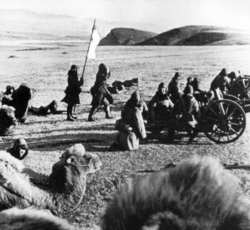
After fighting against insurgents during the early to mid-1930s, the Manchukuo Imperial Army played mainly a supporting role during the actions in Inner Mongolia against Chinese forces, with news reports stating that some Manchukuoan units performed fairly well. Later it fought against the Soviet Red Army during the Soviet–Japanese border conflicts. A skirmish between Manchukuoan and Mongolian cavalry in May 1939 escalated as both sides brought in reinforcements and began the Battle of Khalkhin Gol. Although they did not perform well in the battle overall, the Japanese considered their actions decent enough to warrant expansion of the Manchukuo Army.[145] Throughout the 1940s the only action it saw was against Communist guerrilla fighters and other insurgents, although the Japanese chose to rely only on the more elite units while the majority were used for garrison and security duty.[54] Although Japan took the effort of equipping the Manchukuoan forces with some artillery (in addition to the wide variety it had inherited from Zhang Xueliang's army) along with some elderly tankettes and armored cars,[146] the cavalry was the Imperial Army's most effective and developed branch. This was the force that was confronted by 76 battle-hardened Red Army divisions transferred from the European front in August 1945 during the Soviet invasion of Manchuria. The cavalry branch saw the most action against the Red Army, but the Manchukuo Army and their depleted Japanese Kwantung Army allies were quickly swept aside by the Soviet offensive. While some units remained loyal to their Japanese allies and put up a resistance, many mutinied against their Japanese advisors while others simply melted away into the countryside. Many of these Manchukuo Army troops would later join the Communists since the Chinese Nationalists would execute former collaborators with Japan, which became an important source of manpower and equipment for the Communists in the region.[54]
The other two branches, the Manchukuo Imperial Air Force and the Manchukuo Imperial Navy, were small and underdeveloped, largely existing as token forces to give legitimacy to the Manchukuo regime. An Air Force was established in February 1937 with 30 men selected from the Manchukuo Imperial Army who were trained at the Japanese Kwantung Army aircraft arsenal in Harbin (initially the Kwantung Army did not trust the Manchukuoans enough to train a native air force for them). The Imperial Air Force's predecessor was the Manchukuo Air Transport Company (later renamed the Manchukuo National Airways), a paramilitary airline formed in 1931, which undertook transport and reconnaissance missions for the Japanese military. The first air unit was based in Hsinking (Changchun) and equipped with just one Nieuport-Delage NiD 29 and was later expanded with Nakajima Army Type 91 Fighters and Kawasaki Type 88 light bombers. Two more air units were established, but they suffered a setback when one hundred pilots took their aircraft and defected to insurgents after murdering their Japanese instructors. Nonetheless three fighter squadrons were formed in 1942 from the first batch of cadets, being equipped with Nakajima Ki-27 fighters in addition to Tachikawa Ki-9s and Tachikawa Ki-55 trainers, along with some Mitsubishi Ki-57 transports. In 1945, because of American bombing raids, they were issued with Nakajima Ki-43 fighters to have a better chance of intercepting B-29 Superfortresses. Some pilots saw action against the American bombers and at least one Ki-27 pilot downed a B-29 by ramming his plane into it in a kamikaze attack. The air force practically ceased to exist by the Soviet invasion but there were isolated instances of Manchukuoan planes attacking Soviet forces.[147] The Imperial Navy of Manchukuo existed mainly as a small river flotilla and consisted mainly of small gunboats and patrol boats, both captured Chinese ships and some Japanese additions. The elderly Japanese destroyer Kashi was lent to the Manchukuoan fleet from 1937 to 1942 as the Hai Wei before returning to the Imperial Japanese Navy. These ships were mostly crewed by Japanese In addition to those, several special units that functioned outside of the main command structure of the military also existed. The Manchukuo Imperial Guard was formed out of soldiers of ethnic Manchu descent, charged with the protection of the Kangde Emperor (Puyi) and senior officials, as well as to function as an honor guard. Despite this it took part in combat and was considered to be an effective unit. Throughout the 1930s a "Mongolian Independence Army" was established out of about 6,000 ethnic Mongolian recruits and fought its own war against bandits with some success. It was expanded in 1938 but merged with the regular Imperial Army in 1940, although Mongol units continued to perform well. A special Korean detachment was formed in 1937 on the personal initiative of a businessman of Korean descent. The unit was small but distinguished itself in combat against Communist guerrillas and was noted by the Japanese for its martial spirit, becoming one of the few puppet units to earn the respect of its Japanese superiors.[148]
War crimes in Manchukuo
According to a joint study by historians Zhifen Ju, Mitsuyochi Himeta, Toru Kubo and Mark Peattie, more than 10 million Chinese civilians were mobilized by the Kwangtung Army for slave labor in Manchukuo under the supervision of the Kōa-in.[149]
The Chinese slave laborers often suffered illness due to high-intensity manual labor. Some badly ill workers were directly pushed into mass graves in order to avoid the medical expenditure[150] and the world's most serious mine disaster, at Benxihu Colliery, happened in Manchukuo.
Bacteriological weapons were experimented on humans by the infamous Unit 731 located near Harbin in Beinyinhe from 1932 to 1936 and to Pingfan until 1945. Victims, mostly Chinese, Russians and Koreans, were subjected to vivisection, sometimes without anesthesia.
Drug trafficking
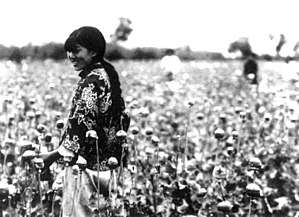
In 2007, an article by Reiji Yoshida in The Japan Times argued that Japanese investments in Manchukuo were partly financed by selling drugs. According to the article, a document found by Yoshida shows that the Kōa-in was directly implicated in providing funds to drug dealers in China for the benefit of the puppet government of Manchukuo, Nanjing and Mongolia.[151] This document corroborates evidence analyzed earlier by the Tokyo tribunal which stated that
Japan's real purpose in engaging in drug traffic was far more sinister than even the debauchery of Chinese people. Japan, having signed and ratified the opium conventions, was bound not to engage in drug traffic, but she found in the alleged but false independence of Manchukuo a convenient opportunity to carry on a worldwide drug traffic and cast the guilt upon that puppet state ... In 1937, it was pointed out in the League of Nations that 90% of all illicit white drugs in the world were of Japanese origin ...[152]
Police
The Manchukuo government also established a police force for general law-enforcement activities. It also included a Marine Police.
Society and culture
National symbols
Aside from the national flag, the orchid, reportedly Puyi's favorite flower, became the royal flower of the country, similar to the chrysanthemum in Japan.[153] The sorghum flower also became a national flower by decree in April 1933.[154] "Five Races Under One Union" was used as a national motto.
Education
Manchukuo developed an efficient public education system.[155] The government established many schools and technical colleges, 12,000 primary schools in Manchukuo, 200 middle schools, 140 normal schools (for preparing teachers), and 50 technical and professional schools. In total the system had 600,000 children and young pupils and 25,000 teachers. Local Chinese children and Japanese children usually attended different schools, and the ones who did attend the same school were segregated by ethnicity, with the Japanese students assigned to better-equipped classes.
Confucius's teachings also played an important role in Manchukuo's public school education. In rural areas, students were trained to practice modern agricultural techniques to improve production. Education focused on practical work training for boys and domestic work for girls, all based on obedience to the "Kingly Way" and stressing loyalty to the Emperor. The regime used numerous festivals, sport events, and ceremonies to foster loyalty of citizens.[156] Eventually, Japanese became the official language in addition to the Chinese taught in Manchukuo schools.
Film
The Photographic Division, part of the public relations section of the South Manchurian Railway was created in 1928 to produce short documentary films about Manchuria to Japanese audiences. In 1937, the Manchukuo Film Association was established by the government and the South Manchurian Railway in a studio in Jilin province. It was founded by Masahiko Amakasu, who also helped the career of Yoshiko Ōtaka, also known as Ri Koran. He also tried to ensure that Manchukuo would have its own industry and would be catering mainly to Manchurian audiences. The films for the most part usually promote pro-Manchukuo and pro-Japanese views. General Amakasu shot various "documentaries" showing carefully choreographed scenes worthy of Hollywood of the Emperor Puyi in his capital of Hsinking (modern Changchun) being cheered by thousands of subjects and reviewing his troops marching in parades that were intended to help legitimize Manchukuo's independence. After World War II, the archives and the equipment of the association were used by the Changchun Film Studio of the People's Republic of China.[157]
Dress
The Changshan and the Qipao, both derived from traditional Manchu dress, were considered national dresses in Manchukuo.
In a meeting with the Concordia Association, the organizers devised what was termed Concordia Costume, or the kyōwafuku, in 1936. Even Japanese such as Masahiko Amakasu and Kanji Ishiwara adopted it. It was gray and a civilianized version of the Imperial Japanese Army uniform. It was similar to the National Clothes (kokumin-fuku) worn by Japanese civilians in World War II as well as the Zhongshan suit. A pin of either a Manchukuo flag or a five-pointed, five colored star with the Manchukuo national colors were worn on the collars.[158] Court dress resembled those of Meiji-era Japan at that time.
Sport
The Manchukuo National Physical Education Association was established in 1932 to promote sport.
Manchukuo also had a national football team, and football was considered the country's de facto national sport; the Football Association of Manchukuo was formed around it.[159]
Manchukuo hosted and participated in baseball matches with Japanese teams.[160] Some of the games of the Intercity Baseball Tournament were held in the country, and played with local teams.[161]
Manchukuo was to compete in the 1932 Summer Olympic Games, but one of the athletes who intended to represent Manchukuo, Liu Changchun, refused to join the team and instead joined as the first Chinese representative in the Olympics. There were attempts by Japanese authorities to let Manchukuo join the 1936 games, but the Olympic Committee persisted in the policy of not allowing an unrecognized state to join the Olympics. Manchukuo had a chance to participate in the planned 1940 Helsinki Olympics, but the onset of World War II prevented the games from taking place.[162] Manchukuo instead sent athletes to compete at the 1940 East Asian Games in Tokyo organised by the Japanese Empire, as a replacement for the cancelled 1940 Summer Olympics.[163]
Stamps and postal history
Manchukuo issued postage stamps from 28 July 1932 until its dissolution following the surrender of the Empire of Japan in August 1945. The last issue of Manchukuo was on 2 May 1945.[164]
In popular culture
In Masaki Kobayashi's The Human Condition (1959), Kaji, the main protagonist, is a labor supervisor assigned to a workforce consisting of Chinese prisoners in a large mining operation in Japanese-colonized Manchuria.[165]
Bernardo Bertolucci's 1987 film The Last Emperor presented a portrait of Manchukuo through the memories of Emperor Puyi, during his days as a political prisoner in the People's Republic of China.[166]
Haruki Murakami's 1995 novel The Wind-Up Bird Chronicle deals greatly with Manchukuo through the character of Lieutenant Mamiya. Mamiya recalls, in person and in correspondence, his time as an officer in the Kwantung Army in Manchukuo. While the period covered in these recollections extends over many years, the focus is on the final year of the war and the Soviet invasion of Manchuria.[167]
The 2008 South Korean western The Good, the Bad, the Weird is set in the desert wilderness of 1930s Manchuria.[168]
See also
Part of a series on the |
|---|
| History of Manchuria |
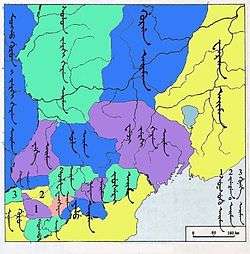 |
|
Ancient period
|
|
Modern period |
- Battle of Lake Khasan
- Collaborationist Chinese Army
- Fengtian clique
- History of the Republic of China
- Japanization
- List of East Asian leaders in the Japanese sphere of influence (1931–1945)
- Manchukuo Temporary Government
- Marco Polo Bridge Incident
- Mengjiang
- Nomonhan
- Northeast Anti-Japanese United Army
Notes
- Although the territories came under the jurisdiction of the Nationalist government before the Chinese Civil War came to its conclusion in 1949, the brief Soviet occupation helped transform the region into a power base for the Chinese Communist troops led by Mao Zedong where the People's Liberation Army could resupply itself with Japanese equipment and gain strategic advantage against the National Revolutionary Army headed by Chiang Kai-shek.
References
Citations
- Encyclopædia Britannica article on Manchukuo Archived 21 December 2007 at the Wayback Machine
- C. Peter Chen. "Manchurian Strategic Offensive Operation | World War II Database". World War II Database. Archived from the original on 4 September 2015. Retrieved 10 September 2015.
- McCormack 1977, p. 4.
- Pʻan 1938, p. 8.
- "Top 10 attractions in Changchun, China – China.org.cn". www.china.org.cn. Archived from the original on 7 July 2018. Retrieved 11 April 2019.
- Smith 2012, p. 219.
- Tamanoi 2000, p. 249.
- Giles 1912, p. 8.
- Garcia 2012, p. 15.
- Hauer 2007, p. 117.
- Dvořák 1895, p. 80.
- Wu 1995, p. 102.
- Zhao 2006, pp. 4, 7–14.
- Clausen 1995, p. 7.
- "Russia and China end 300-year-old border dispute". BBC News. 10 November 1997. Archived from the original on 6 November 2011. Retrieved 14 August 2010.
- Nish, Ian (2014). The Origins of the Russo-Japanese War. Routledge. p. 31. ISBN 9780582491144.
- Jay Robert Nash (28 October 1997). Spies: A Narrative Encyclopedia of Dirty Tricks and Double Dealing from Biblical Times to Today. M. Evans. p. 99. ISBN 978-1-4617-4770-3.
- Marie-Claire Bergère; Janet Lloyd (1998). Sun Yat-sen. Stanford University Press. p. 132. ISBN 978-0-8047-4011-1.
- Gerald Horne (2005). Race War!: White Supremacy and the Japanese Attack on the British Empire. NYU Press. p. 252. ISBN 978-0-8147-3641-8.
- Dooeum Chung (2000). Élitist fascism: Chiang Kaishek's Blueshirts in 1930s China. Ashgate. p. 61. ISBN 978-0-7546-1166-0.
- Dooeum Chung (1997). A re-evaluation of Chiang Kaishek's blueshirts: Chinese fascism in the 1930s. University of London. p. 78.
- Rodney Carlisle (26 March 2015). Encyclopedia of Intelligence and Counterintelligence. Routledge. p. 71. ISBN 978-1-317-47177-6.
- Young 1998, p. 33.
- Young 1998, p. 31.
- Young 1998, p. 34.
- Fenby, Jonathan (2003). Generalissimo: Chiang Kai-shek and the China he lost. London: Free. p. 103. ISBN 9780743231442.
- Young 1998, p. 38.
- Reginald Fleming Johnston, p. 438.
- Between World Wars Archived 31 October 2006 at the Wayback Machine
- Continent, coast, ocean: dynamics of regionalism in Eastern Asia by Universiti Kebangsaan Malaysia. Institut Alam dan Tamadun Melayu, Institute of Southeast Asian Studies p.20 Archived 13 June 2014 at the Wayback Machine
- Yamamuro, Shin·ichi (2006). Manchuria under Japanese domination. Translated by Fogel, Joshua A. Philadelphia, Pa.: University of Pennsylvania Press. pp. 116–117. ISBN 9780812239126.
- "MANCHUKUO". www.banknote.ws. Archived from the original on 29 November 2016. Retrieved 11 December 2016.
- Future of American Trade with Manchukuko, Roy H Akagi, 3 June 1940, accessed September 2009
- "Stamp Atlas China". www.sandafayre.com. Archived from the original on 22 February 2013. Retrieved 11 December 2016.
- Young 1998, pp. 88–93.
- Young 1998, p. 95.
- Young 1998, p. 85.
- "Chinese Eastern Railway railway, China". Encyclopædia Britannica. Archived from the original on 21 December 2016. Retrieved 11 December 2016.
- "Stimson Doctrine, 1932". United States Department of State. Retrieved 10 December 2016.
- Nish, Ian Hill (2002), Japanese foreign policy in the interwar period, Westport, CT: Praeger, p. 95, ISBN 0-275-94791-2
- Turns, David. "Stimson Doctrine of Non-Recognition: Its Historical Genesis and Influence on Contemporary International Law, The." Chinese J. Int'l L. 2 (2003): 123.
- Kotkin, Stephen (2000), Mongolia in the Twentieth Century: Landlocked Cosmopolitan, Routledge, p. 123, ISBN 0765605368
- Генеральное консульство СССР в Харбине Archived 18 March 2014 at the Wayback Machine
- Ivanov, Igor (2002). Outline of the History of the Minister of Foreign Affairs of Russia. In Russian. OLMA Media Group, p. 219
- Chronology of China in the 1940s Archived 23 October 2014 at the Wayback Machine. Osaka University School of Law. Retrieved 29 December 2017.
- K. A. Karayeva. МАНЬЧЖОУ ГО (1931–1945): «МАРИОНЕТОЧНОЕ» ГОСУДАРСТВО В СИСТЕМЕ МЕЖДУНАРОДНЫХ ОТНОШЕНИЙ НА ДАЛЬНЕМ ВОСТОКЕ Archived 3 September 2014 at the Wayback Machine. Ural Federal University archives.
- Valente, Gianni. "Vatican-Manchukuo, mea culpas are not necessary". 30giorni. Archived from the original on 3 February 2014. Retrieved 25 February 2013.
- Pollard, John (2014), The Papacy in the Age of Totalitarianism, Oxford University Press, p. 329, ISBN 978-0199208562
- Suomen diplomaattiset suhteet ulkovaltoihin 1918–1996. Ulkoasiainministeriön julkaisuja (in Finnish). Helsinki: Ministry for Foreign Affairs of Finland. 1997. p. 139. ISBN 951-724-118-6.
- 李, 世峥 (1 September 2010). "基督徒将军佟麟阁:抗战殉国的第一位高级将领". 中国民族报. Archived from the original on 24 May 2018. Retrieved 4 June 2018.
- "佟麟阁中国抗日战争牺牲的第一位高级将领". 每日头条. 27 May 2017.
- "佟麟阁中国抗日战争牺牲的第一位高级将领". 每日头条. 27 May 2017. Archived from the original on 24 May 2018.
- Coox, Alvin D. (1990). Nomonhan : Japan against Russia, 1939 (1st ed.). Stanford, Calif.: Stanford University Press. p. 841. ISBN 978-0804718356.
- Jowett 2004, pp. 36–38.
- Behr 1987, p. 285.
- Borisov, O. (1977). The Soviet Union and the Manchurian Revolutionary Base (1945–1949). Moscow, Progress Publishers.
- Paul K. Maruyama, Escape from Manchuria (iUniverse, 2009) ISBN 978-1-4502-0581-8 (hard cover), 9781450205795 (paperback), based on the earlier books in Japanese by K. Maruyama (1970) and M. Musashi (2000) and other sources
- Columbia Encyclopedia article on Manchukuo Archived 13 March 2007 at the Wayback Machine
- Doak, Kevin Michael (2004), "Review: Sovereignty and Authenticity: Manchukuo and the East Asian Modern by Prasenjit Duara", The Journal of Japanese Studies, 30 (2): 502–507, doi:10.1353/jjs.2004.0054, ISSN 0095-6848, JSTOR 25064511
- Young 1998, p. 269.
- Young 1998, p. 278.
- Young 1998, p. 293.
- Fogel 1995, p. 125.
- Young 1998, pp. 296–297.
- Young 1998, p. 298.
- Young 1998, pp. 269–270.
- Young 1998, p. 282.
- Young 1998, p. 294.
- Young 1998, p. 302.
- Fogel 1995, p. 126.
- Young 1998, p. 287.
- Young 1998, p. 276.
- Fogel 1995, p. 124.
- Young 1998, p. 299.
- Hotta 2007, p. 128.
- Hotta 2007, p. 126.
- Westad, Odd Arne (2012). Restless Empire: China and the World Since 1750. Basic Books. p. 252. ISBN 978-0465056675.
- Bong 2014, p. 137–138.
- Bong 2014, p. 138.
- Bong 2014, p. 146.
- Bong 2014, p. 140.
- Smirnov, Sergei (2015). "The Russian Officer Corps of the Manchukuo Army". The Journal of Slavic Military Studies. 28 (3).
- Behr 1987, p. 202.
- Behr 1987, pp. 202–203.
- Behr 1987, p. 203.
- Bisher, Jamie (2005). White Terror: Cossack Warlords of the Trans-Siberian. London: Psychology Press. p. 305. ISBN 0415571340.
- Bong 2014, pp. 138, 146.
- Bong 2014, p. 144.
- Bong 2014, pp. 148–149.
- Bong 2014, pp. 153–154.
- Kearney, Gerald David (1993). "Jews Under Japanese Domination, 1939–1945". Shofar: An Interdisciplinary Journal of Jewish Studies. 11 (3).
- Ember, M.; Ember, C.R.; Skoggard, I., eds. (2005). Encyclopedia of Diasporas: Immigrant and Refugee Cultures Around the World. Springer. p. 159.
- Tamanoi 2000, p. 253.
- Tamanoi 2000, p. 255.
- Young 1998, p. 258.
- Young 1998, p. 259.
- Ward, Rowena (1 March 2007). "Left Behind: Japan's Wartime Defeat and the Stranded Women of Manchukuo". The Asia Pacific Journal. 5 (3). ISSN 1557-4660. Archived from the original on 12 January 2016.
- Mackerras, Colin (2003). Ethnicity in Asia. Psychology Press. p. 59. ISBN 9780415258166.
- "Oroqen". Encyclopedia of World Cultures. Archived from the original on 24 May 2018. Retrieved 23 May 2018 – via Encyclopedia.com.
- "The Oroqen Ethnic Group". China.org.cn. 21 June 2005.
- "The Oroqen ethnic minority". Embassy of the People's Republic of China in the Republic of Estonia. 17 May 2004. Archived from the original on 24 May 2018.
- "OROQEN". Archived from the original on 17 June 2018. Retrieved 4 June 2018.
- "China's ethnic minorities". 27 January 2010. Retrieved 4 June 2018.
- Carsten Naeher; Giovanni Stary; Michael Weiers (2002). Proceedings of the First International Conference on Manchu-Tungus Studies, Bonn, August 28 – September 1, 2000: Trends in Tungusic and Siberian linguistics. Otto Harrassowitz Verlag. p. 120. ISBN 978-3-447-04628-2.
- Wu, Haiyun (28 July 2017). "The Last of the Oroqen Hunters". Sixth Tone. Archived from the original on 24 May 2018.
- James Stuart Olson (1998). An Ethnohistorical Dictionary of China. Greenwood Publishing Group. p. 141. ISBN 978-0-313-28853-1.
- DuBois 2008, pp. 287–288.
- DuBois 2008, p. 292.
- Behr 1987, p. 218.
- DuBois 2008, p. 293.
- DuBois 2008, pp. 293–294.
- DuBois 2010, pp. 751–752.
- DuBois 2008, pp. 294–295.
- DuBois 2008, p. 298.
- DuBois 2010, p. 752.
- DuBois 2010, p. 753.
- DuBois 2010, pp. 753–754.
- DuBois 2010, p. 757.
- DuBois 2010, pp. 757–758.
- DuBois 2010, p. 758.
- DuBois 2010, p. 761.
- DuBois 2010, pp. 762–763.
- DuBois 2008, p. 300.
- DuBois 2008, p. 302.
- DuBois 2008, p. 306.
- DuBois 2008, p. 308.
- DuBois 2008, p. 309.
- DuBois 2008, p. 310.
- DuBois 2008, p. 311.
- DuBois 2008, p. 312.
- DuBois 2008, pp. 312–313.
- DuBois 2008, p. 313.
- DuBois 2008, pp. 313–314.
- DuBois 2008, pp. 315–316.
- Maiolo, Joseph (2010). Cry Havoc: How the Arms Race Drove the World to War, 1931–1941. New York: Basic Books. pp. 28–30. ISBN 978-0465032297.
- "The Unquiet Past Seven decades on from the defeat of Japan, memories of war still divide East Asia". The Economist. 12 August 2015. Archived from the original on 6 September 2015. Retrieved 9 September 2015.
- Prasenjit Duara. "The New Imperialism and the Post-Colonial Developmental State: Manchukuo in comparative perspective". Archived from the original on 16 June 2010. Retrieved 25 July 2010.
- Glantz 2003, p. 60.
- Jowett 2004, pp. 35–38.
- Jowett 2004, pp. 7–9.
- Jowett 2004, pp. 22–23.
- Jowett 2004, pp. 27–28.
- Holland 2008, p. 84.
- Jowett 2004, pp. 11–13.
- Jowett 2004, pp. 25–27.
- Jowett 2004, pp. 15–17.
- Jowett 2004, pp. 90–92.
- Jowett 2004, pp. 31–35.
- Ju, Zhifen (2002), Japan's atrocities of conscripting and abusing north China draftees after the outbreak of the Pacific war
- Municipal Government Information Office (2005), Repatriation of one million Japanese via Huludao, Beijing: China Intercontinental Press, p. 25, ISBN 7-5085-0735-5
- Japan profited as opium dealer wartime China Archived 15 March 2008 at the Wayback Machine
- Chapter 5: HyperWar: International Military Tribunal for the Far East, archived from the original on 27 September 2007
- "国立公文書館 アジア歴史資料センター". jacar.go.jp. Archived from the original on 5 January 2016. Retrieved 10 September 2015.
- 千田萬三『満洲事典』満鉄社員会、1939年(昭和14年)
- Hawkins, Everett D. (12 March 1947). "Education in Manchuria". Far Eastern Survey. 16 (5): 52–54. doi:10.1525/as.1947.16.5.01p0155j. JSTOR 3021748.
- Japan Focus Archived 26 October 2005 at the Wayback Machine.
- Baskett, Michael (2008). The Attractive Empire: Transnational Film Culture in Imperial Japan. Honolulu: University of Hawai'i Press. pp. 29, 31–32, 77–79, 115. ISBN 978-0-8248-3223-0.
- Brandt, Kim. Kingdom of Beauty: Mingei and the Politics of Folk Art in Imperial Japan. Durham and London: Duke UP, 2007.
- "満州国の国技は"蹴球"-読売新聞記事より : 蹴球本日誌". fukuju3.cocolog-nifty.com. 1 October 2010. Archived from the original on 27 September 2015. Retrieved 10 September 2015.
- Grasso, June (2019). "2". Japan's "New Deal" for China Propaganda Aimed at Americans Before Pearl Harbor. New York, NY: Routledge. ISBN 978-0-8153-6930-1. Retrieved 20 June 2020.
- Grasso, June (2019). "2". Japan's "New Deal" for China Propaganda Aimed at Americans Before Pearl Harbor. New York, NY: Routledge. ISBN 978-0-8153-6930-1. Retrieved 20 June 2020.
- Mangan, J. A.; Collins, Sandra; Ok, Gwang (2018). The Triple Asian Olympics - Asia Rising: The Pursuit of National Identity, International Recognition and Global Esteem. Taylor & Francis. p. 119. ISBN 978-1-135-71419-2.
- Collins, Sandra (2014). 1940 TOKYO GAMES – COLLINS: Japan, the Asian Olympics and the Olympic Movement. Routledge. pp. 179–180. ISBN 978-1317999669.
- "Manchukuo and Manchurian Stamps 1945–10th Anniversary of the Emperors Edict". manchukuostamps.com. Retrieved 24 October 2019.
- Grilli, Peter. "Interview with Masaki Kobayashi". Nihon Cine Art. Archived from the original on 2 April 2015. Retrieved 15 March 2015.
- McCarthy, Todd (11 May 2009). "'The Last Emperor' – Variety Review". Variety. Archived from the original on 1 January 2013. Retrieved 6 February 2013.
- James, Jamie (2 November 1997). "East Meets West". The New York Times. ISSN 0362-4331. Archived from the original on 5 March 2018. Retrieved 18 February 2018.
- Elley, Derek (24 May 2008). "The Good The Bad The Weird". Variety. Archived from the original on 18 February 2018. Retrieved 18 February 2018.
Cited sources
- Behr, Edward (1987). The Last Emperor. Toronto: Futura. ISBN 0553344749.CS1 maint: ref=harv (link)
- Bong, Inyoung (2014). "A "White Race" without Supremacy: Russians, Racial Hybridity, and Liminality in the Chinese Literature of Manchukuo". Modern Chinese Literature and Culture. 26 (1): 137–190. JSTOR 42940475.CS1 maint: ref=harv (link)
- Clausen, Søren (1995). The Making of a Chinese City: History and Historiography in Harbin. Contributor: Stig Thøgersen (illustrated ed.). M.E. Sharpe. ISBN 1563244764. Retrieved 10 March 2014.CS1 maint: ref=harv (link)
- DuBois, Thomas David (August 2010). "Inauthentic Sovereignty: Law and Legal Institutions in Manchukuo". Journal of Asian Studies. 69 (3): 749–770. doi:10.1017/S002191181000152X. JSTOR 40929191.CS1 maint: ref=harv (link)
- DuBois, Thomas David (2008). "Rule of Law in a Brave New Empire: Legal Rhetoric and Practice in Manchukuo" (PDF). Law and History Review. 26 (2): 285–319. doi:10.1017/s0738248000001322.CS1 maint: ref=harv (link)
- Dvořák, Rudolf (1895). Chinas religionen . Volume 12; Volume 15 of Darstellungen aus dem Gebiete der nichtchristlichen Religionsgeschichte (illustrated ed.). Aschendorff (Druck und Verlag der Aschendorffschen Buchhandlung). ISBN 0199792054. Retrieved 10 March 2014.CS1 maint: ref=harv (link)
- Elliott, Mark C. (August 2000). "The Limits of Tartary: Manchuria in Imperial and National Geographies" (PDF). The Journal of Asian Studies. Association for Asian Studies. 59 (3): 603–646. doi:10.2307/2658945. JSTOR 2658945. Archived from the original (PDF) on 17 December 2016. Retrieved 17 December 2016.CS1 maint: ref=harv (link)
- Fogel, Joshua (1995). The Cultural Dimensions of Sino-Japanese Relations: Essays on the Nineteenth and Twentieth Centuries. London: Routledge. ISBN 1563244446.CS1 maint: ref=harv (link)
- Garcia, Chad D. (2012). Horsemen from the Edge of Empire: The Rise of the Jurchen Coalition (PDF) (A dissertation submitted in partial fulfillment of the requirements for the degree of Doctor of Philosophy). University of Washington. pp. 1–315. Retrieved 6 September 2014.CS1 maint: ref=harv (link)
- Glantz, David (2003). The Soviet Strategic Offensive in Manchuria, 1945: August Storm. Routledge. ISBN 978-0415408615.CS1 maint: ref=harv (link)
- Giles, Herbert A. (1912). China and the Manchus. (Cambridge : at the University Press) (New York : G. P. Putnam's Sons). Retrieved 31 January 2014.CS1 maint: ref=harv (link)
- Hauer, Erich (2007). Corff, Oliver (ed.). Handwörterbuch der Mandschusprache. Volume 12; Volume 15 of Darstellungen aus dem Gebiete der nichtchristlichen Religionsgeschichte (illustrated ed.). Otto Harrassowitz Verlag. ISBN 978-3447055284. Retrieved 10 March 2014.CS1 maint: ref=harv (link)
- Holland, Douglas (2008). The State of Sovereignty: Territories, Laws, Populations. Indiana University Press. ISBN 978-0253220165.CS1 maint: ref=harv (link)
- Hotta, Eri (2007). Pan-Asianism and Japan's War 1931-1945. London: Palgrave. ISBN 9780230601031.CS1 maint: ref=harv (link)
- Jowett, Philip (2004). Rays of the Rising Sun, Volume 1: Japan's Asian Allies 1931–45, China and Manchukuo. Helion and Company Ltd. ISBN 1-874622-21-3.CS1 maint: ref=harv (link)
- McCormack, Gavan (1977). Chang Tso-lin in Northeast China, 1911-1928: China, Japan, and the Manchurian Idea (illustrated ed.). Stanford University Press. ISBN 0804709459. Retrieved 10 March 2014.CS1 maint: ref=harv (link)
- Pʻan, Chao-ying (1938). American Diplomacy Concerning Manchuria. The Catholic University of America. Retrieved 10 March 2014.CS1 maint: ref=harv (link)
- Pozzi, Alessandra; Janhunen, Juha Antero; Weiers, Michael, eds. (2006). Tumen Jalafun Jecen Aku: Manchu Studies in Honour of Giovanni Stary. Volume 20 of Tunguso Sibirica. Contributor: Giovanni Stary. Otto Harrassowitz Verlag. ISBN 344705378X.
- Sewell, Bill (2003). Edgington, David W. (ed.). Japan at the Millennium: Joining Past and Future (illustrated ed.). UBC Press. ISBN 0774808993. Retrieved 10 March 2014.CS1 maint: ref=harv (link)
- Smith, Norman (2012). Intoxicating Manchuria: Alcohol, Opium, and Culture in China's Northeast. Contemporary Chinese Studies Series (illustrated ed.). UBC Press. ISBN 978-0774824316. Retrieved 10 March 2014.CS1 maint: ref=harv (link)
- Tamanoi, Mariko Asano (May 2000). "Knowledge, Power, and Racial Classification: The "Japanese" in "Manchuria"". The Journal of Asian Studies. Association for Asian Studies. 59 (2): 248–276. doi:10.2307/2658656. JSTOR 2658656.CS1 maint: ref=harv (link)
- Wolff, David; Steinberg, John W., eds. (2007). The Russo-Japanese War in Global Perspective: World War Zero, Volume 2. Volume 2 of The Russo-Japanese War in Global Perspective (illustrated ed.). BRILL. ISBN 978-9004154162.CS1 maint: ref=harv (link)
- Wu, Shuhui (1995). Die Eroberung von Qinghai unter Berücksichtigung von Tibet und Khams 1717–1727: anhand der Throneingaben des Grossfeldherrn Nian Gengyao. Volume 2 of Tunguso Sibirica (reprint ed.). Otto Harrassowitz Verlag. ISBN 3447037563. Retrieved 10 March 2014.CS1 maint: ref=harv (link)
- Young, Louise (1998). Japan's Total Empire: Manchuria and the Culture of Wartime Imperialism. University of California Press. ISBN 9780520210714.CS1 maint: ref=harv (link)
- Zhao, Gang (January 2006). "Reinventing China Imperial Qing Ideology and the Rise of Modern Chinese National Identity in the Early Twentieth Century". Modern China. Sage Publications. 32 (1): 3–30. doi:10.1177/0097700405282349. JSTOR 20062627.CS1 maint: ref=harv (link)
Further reading
- Toshihiko Kishi, Mitsuhiro MATSUSHIGE and MATSUMURA Fuminori MATSUMURA, eds, 20 Seiki Manshu Rekishi Jiten [Encyclopedia of 20th Century Manchuria History], Tokyo: Yoshikawa Kobunkan, 2012, ISBN 978-4642014694
- Toshihiko Kishi. "Manchuria's Visual Media Empire (Manshukoku no Visual Media): Posters, Pictorial Post Cards, Postal Stamps", Tokyo: Yoshikawa Kobunkan, 10 June 2010. ISBN 978-4-642-08036-1
- Reginald Fleming Johnston. "Twilight in the Forbidden City". Soul Care Publishing, 18 March 2008. ISBN 978-0-9680459-5-4.
- Fleming, Peter, Travel's in Tartary: One's Company and News from Tartary: 1941 (Part one: Manchukuo)
- Smith, Lloyd (January 1940). Everybodys Complete Encyclopedia. Whitman Publishing Company. Racine, Wisconsin. p. 462
- Clauss, Errol MacGregor. "The Roosevelt Administration and Manchukuo, 1933–1941", Historian (1970), 32#4 pp 595–611.
- Duara, Prasenjit. Sovereignty and Authenticity: Manchukuo and the East Asian Modern (2004)
- Elliott, Mark C (2003). "The Limits of Tartary: Manchuria in Imperial and National Geographies". Journal of Asian Studies. 59 (3): 603–646.
- Power, Brian. Puppet Emperor: The Life of Pu Yi, Last Emperor of China (1988)
- Yamamuro, Shin'ichi. Manchuria under Japanese Dominion (U. of Pennsylvania Press, 2006)
- Review in The Journal of Japanese Studies 34.1 (2007) 109–114 online
- Mitter, Rana. The Manchurian Myth: Nationalism, Resistance, and Collaboration in Modern China (2000)
External links
| Wikimedia Commons has media related to Manchukuo. |
- Manchukuo Propaganda Posters & Bills
- Manchukuo Imperial Army
- Manchu Money Museum
- Education in Mongolia and Manchukuo
- Manchukuo Flags
- "On Macro-economic Statistics for Manchukuo" by Yuzo Yamamoto
- "Toshiro Matsumoto s research over Manchukuo"
- "Vaticano-Manchukuo no sirve de mea culpa" by Gianni Valente
- "Manchukuo National Anthem"
- JAPAN-MANCHOUKUO PROTOCOL
- "References over Manchukuo"
- Zionism and the Japanese East Asia Co-Prosperity Sphere
- Japanese references to Mantetsu Railway Company
- Mukden Incident photos
